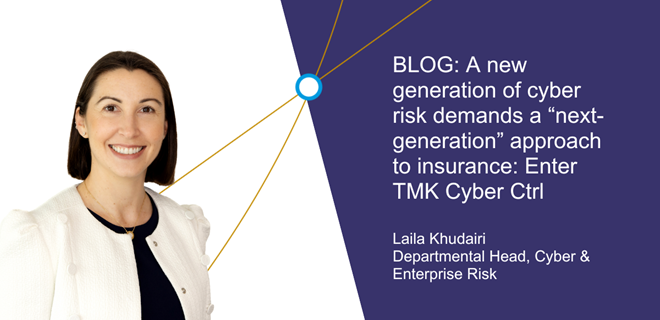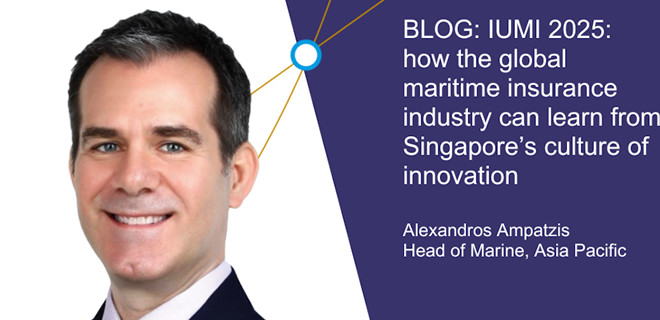
Insights

IUMI 2025: how the global maritime insurance industry can learn from Singapore’s culture of innovation
By Alexandros Ampatzis, Head of Marine, Asia Pacific
Wednesday, September 3, 2025
At a time of profound upheaval and volatility, maritime insurance continues to display its worth as a fundamental driver of resilience and growth for the global economy. From helping clients to navigate geopolitical instability in places like the Red Sea, to supporting businesses manage new free trade rules, or helping organisations understand the risks of rapid adoption of AI on their operations, the global maritime insurance industry is at the vanguard of innovation and risk navigation.
I’ve been following the discussions and outcomes of the International Union of Marine Insurance (IUMI) conference for more than 20 years. They are always interesting and always relevant. But this year’s conference, set against the backdrop of such global change, is more important than ever.
Navigating risks and opportunities
“Charting Opportunities in Changing Tides”, the theme for this year’s event, perfectly encapsulates the dichotomy that our industry and our clients face. How does maritime insurance adapt to emerging risks while capitalising on new opportunities at the same time?
Singapore, our host venue for this year’s conference, may hold the answer to some of these questions.
Maritime innovation
As one of the world’s leading shipping hubs, Singapore has placed adaptation and innovation at the heart of its maritime economy. It is home to more than 5,000 maritime establishments, supporting nearly 200,000 jobs in the sector, while handling more than 40 million twenty-foot equivalent units (TEUs) annually, and it is currently set to automate its entire operation by 2030.
This move will see a fleet of fast-charging electric guided vehicles that will move autonomously through the terminal, transporting shipping containers between the wharf and the port. All of this will be controlled remotely with operators watching through a large screen showing a digital twin of the facility.
This will drive the efficient operations and reduce the turnaround time of ships, increasing the capacity at which the port can operate. When fully operational, it will exceed the number of units handled in Shanghai – the biggest port in the world - by 15m TEUs per year. It will also cut carbon emissions by roughly 50%. Within an industry that transports 80% of the world’s cargo, this is vitally important in the fight against climate change.
COVID-19: a catalyst for change
The effects of the COVID-19 pandemic served as a catalyst for this change, exposing vulnerabilities in the supply chain system and amplifying existing challenges such as product shortages, shipping backlogs and rising inflation. Automation is a way to future proof the port against these issues, but we must acknowledge that it throws up new ones.
Relying on technology increases the likelihood of cyber-attacks, especially within the current geopolitical landscape. In turn, the potential for disruption of shipping, supply chains and major trade routes is significant with a knock-on impact on insurance.
Automation minimises exposure to human error or strikes, while data analytics, predictive modelling and machine learning are becoming indispensable tools for risk assessment and decision making among carriers, enabling them to assess risks more accurately, price policies effectively, and respond proactively to emerging threats.
However, automation may well amplify other risks, including systematic errors and algorithms being trained on incorrect data. This will necessitate a period of profound transformation in terms of how products are sold, priced and underwritten. Marine underwriters will need to shift from a manual, traditional approach to one of strategic oversight and management of analytics, handling exceptional cases and identifying risks that technology might not yet be able to.
It is clear that Singapore is truly taking advantage of the new opportunities created by automation. Discussions at IUMI will need to focus on how the insurance industry should follow suit in order to keep pace with the new risks and opportunities it presents.
Let’s connect at IUMI
If you are going to IUMI, and would like to catch up, please do get in touch.
LATEST INSIGHTS

Flying out of danger: using real-time data to avert a potential aviation disaster
By Will Green, Divisional Head of Airline, Contingent & War
16 October 2025
Decades of conflict in eastern DRC have escalated in 2025, with rebel advances threatening key infrastructure. This blog explores how real-time intelligence helped aviation clients respond swiftly to emerging risks—and how insurers are evolving to proactively mitigate geopolitical threats.

A new generation of cyber risk demands a “next-generation” approach to insurance: Enter TMK Cyber Ctrl
By Laila Khudairi, Departmental Head of Cyber & Enterprise Risk
25 September 2025
Cyber threats have steadily increased in sophistication and scale, with attacks costing the global economy billions every year. Cybercriminals have evolved from lone wolves to groups akin to mid-sized corporations with HR departments and training programmes.

IUMI 2025: how the global maritime insurance industry can learn from Singapore’s culture of innovation
By Alexandros Ampatzis, Head of Marine, Asia Pacific
03 September 2025
It is clear that Singapore is truly taking advantage of the new opportunities created by automation. Discussions at IUMI will need to focus on how the insurance industry should follow suit in order to keep pace with the new risks and opportunities it presents.